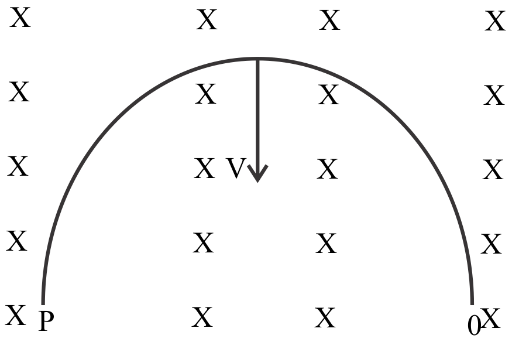
A semicircle loop PQ of radius $R$ is moved with velocity $v$ in transverse magnetic field as shown in fig. The value of induced emf at the end of the loop is

A. $Bv\pi R$ end P at high potential
B. $2BRv$end P at high potential
C. $2BRv$end Q at high potential
D. $\dfrac{{B\pi {R^2}v}}{2}$ end P at high potential
Answer
123k+ views
Hint: First put the above values in the formula for induced emf in a conductor moving with a given velocity. One important thing to consider is that the emf induced only depends upon the ends of the conductor and not the shape. Then using Fleming’s right hand rule, we can determine which end will have high potential.
Formula used:
$\varepsilon = Bvl$ where $\varepsilon $is the emf induced in the conductor of length $l$ when it moves in a magnetic field $B$ with velocity $v$.
$\varepsilon = - \dfrac{{d\Phi }}{{dt}}$ where $\Phi $ is the magnetic flux linked with the conductor.
Complete step by step solution
When a conductor of length $l$ is moving with a constant velocity $v$ in a magnetic field $\overrightarrow B $, an emf or a potential difference is induced between the two ends of the conductor. This emf is given as,
$\varepsilon = Bvl$when the conductor moves in a direction perpendicular to the magnetic field
Taking $l = 2R$ as the induced emf only depends upon the ends of a conductor.
Therefore, $\varepsilon = 2BRv$
Another way of calculating the emf induced within the conductor is by taking the time derivative of the magnetic flux linked with the conductor, which is given as,
$\varepsilon = - \dfrac{{d\Phi }}{{dt}}$
The magnetic flux through the conductor is given as,
$\Phi = BA$$ = Bldx$
So, $\varepsilon = - 2BR\dfrac{{dx}}{{dt}}$ [As induced emf only depends upon the ends of a conductor, $l = 2R$]
$ \Rightarrow \varepsilon = - 2BRv$
Taking the absolute value we get,
$\varepsilon = 2BRv$
This is the emf induced in the semicircular loop PQ.
Now, by using Fleming’s right hand rule which states that if we stretch the right-hand thumb and two nearby fingers perpendicular to one another, and the first finger points in the direction of the magnetic field and the thumb is in the direction of motion of the conductor, then the middle finger will point in the direction of the induced current, we can show that P is at low potential and Q is at high potential.
So, the correct option is C.
Note: The direction of the induced emf, or the current, in any circuit is such as to oppose the cause that produces it. This is known as Lenz’s law.
Formula used:
$\varepsilon = Bvl$ where $\varepsilon $is the emf induced in the conductor of length $l$ when it moves in a magnetic field $B$ with velocity $v$.
$\varepsilon = - \dfrac{{d\Phi }}{{dt}}$ where $\Phi $ is the magnetic flux linked with the conductor.
Complete step by step solution
When a conductor of length $l$ is moving with a constant velocity $v$ in a magnetic field $\overrightarrow B $, an emf or a potential difference is induced between the two ends of the conductor. This emf is given as,
$\varepsilon = Bvl$when the conductor moves in a direction perpendicular to the magnetic field
Taking $l = 2R$ as the induced emf only depends upon the ends of a conductor.
Therefore, $\varepsilon = 2BRv$
Another way of calculating the emf induced within the conductor is by taking the time derivative of the magnetic flux linked with the conductor, which is given as,
$\varepsilon = - \dfrac{{d\Phi }}{{dt}}$
The magnetic flux through the conductor is given as,
$\Phi = BA$$ = Bldx$
So, $\varepsilon = - 2BR\dfrac{{dx}}{{dt}}$ [As induced emf only depends upon the ends of a conductor, $l = 2R$]
$ \Rightarrow \varepsilon = - 2BRv$
Taking the absolute value we get,
$\varepsilon = 2BRv$
This is the emf induced in the semicircular loop PQ.
Now, by using Fleming’s right hand rule which states that if we stretch the right-hand thumb and two nearby fingers perpendicular to one another, and the first finger points in the direction of the magnetic field and the thumb is in the direction of motion of the conductor, then the middle finger will point in the direction of the induced current, we can show that P is at low potential and Q is at high potential.
So, the correct option is C.
Note: The direction of the induced emf, or the current, in any circuit is such as to oppose the cause that produces it. This is known as Lenz’s law.
Recently Updated Pages
How to find Oxidation Number - Important Concepts for JEE

How Electromagnetic Waves are Formed - Important Concepts for JEE

Electrical Resistance - Important Concepts and Tips for JEE

Average Atomic Mass - Important Concepts and Tips for JEE

Chemical Equation - Important Concepts and Tips for JEE

Concept of CP and CV of Gas - Important Concepts and Tips for JEE

Trending doubts
JEE Main 2025 Session 2: Application Form (Out), Exam Dates (Released), Eligibility & More

JEE Main Login 2045: Step-by-Step Instructions and Details

JEE Main Chemistry Question Paper with Answer Keys and Solutions

JEE Main Exam Marking Scheme: Detailed Breakdown of Marks and Negative Marking

JEE Main 2023 January 24 Shift 2 Question Paper with Answer Keys & Solutions

JEE Main Chemistry Exam Pattern 2025

Other Pages
JEE Advanced Marks vs Ranks 2025: Understanding Category-wise Qualifying Marks and Previous Year Cut-offs

JEE Advanced 2025: Dates, Registration, Syllabus, Eligibility Criteria and More

Learn About Angle Of Deviation In Prism: JEE Main Physics 2025

JEE Main 2025: Conversion of Galvanometer Into Ammeter And Voltmeter in Physics

Dual Nature of Radiation and Matter Class 12 Notes: CBSE Physics Chapter 11

Electric field due to uniformly charged sphere class 12 physics JEE_Main




